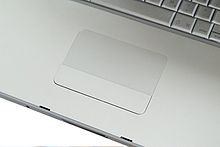A touch pad is a device for pointing (controlling input positioning) on a computer display screen. It is an alternative to the mouse. Originally incorporated in laptop computers, touch pads are also being made for use with desktop computers. A touch pad works by sensing the user's finger movement and downward pressure.
The first touch pad was invented by George E. Gerpheide in 1988. Apple Computer was the first to license and use the touch pad in its Powerbook laptops in 1994. The touch pad has since become the leading cursor controlling device in laptops. many laptops use a trackball. IBM ThinkPad laptops use a "pointing stick" (called a TrackPoint) that is set into the keyboard.
How the Touch Pad Works
The touch pad contains several layers of material. The top layer is the pad that you touch. Beneath it are layers (separated by very thin insulation) containing horizontal and vertical rows of electrodes that form a grid. Beneath these layers is a circuit board to which the electrode layers are connected. The layers with electrodes are charged with a constant alternating current (AC). As the finger approaches the electrode grid, the current is interrupted and the interruption is detected by the circuit board. The initial location where the finger touches the pad is registered so that subsequent finger movement will be related to that initial point. Some touch pads contain two special places where applied pressure corresponds to clicking a left or right mouse button. Other touch pads sense single or double taps of the finger at any point on the touch pad.


No comments:
Post a Comment